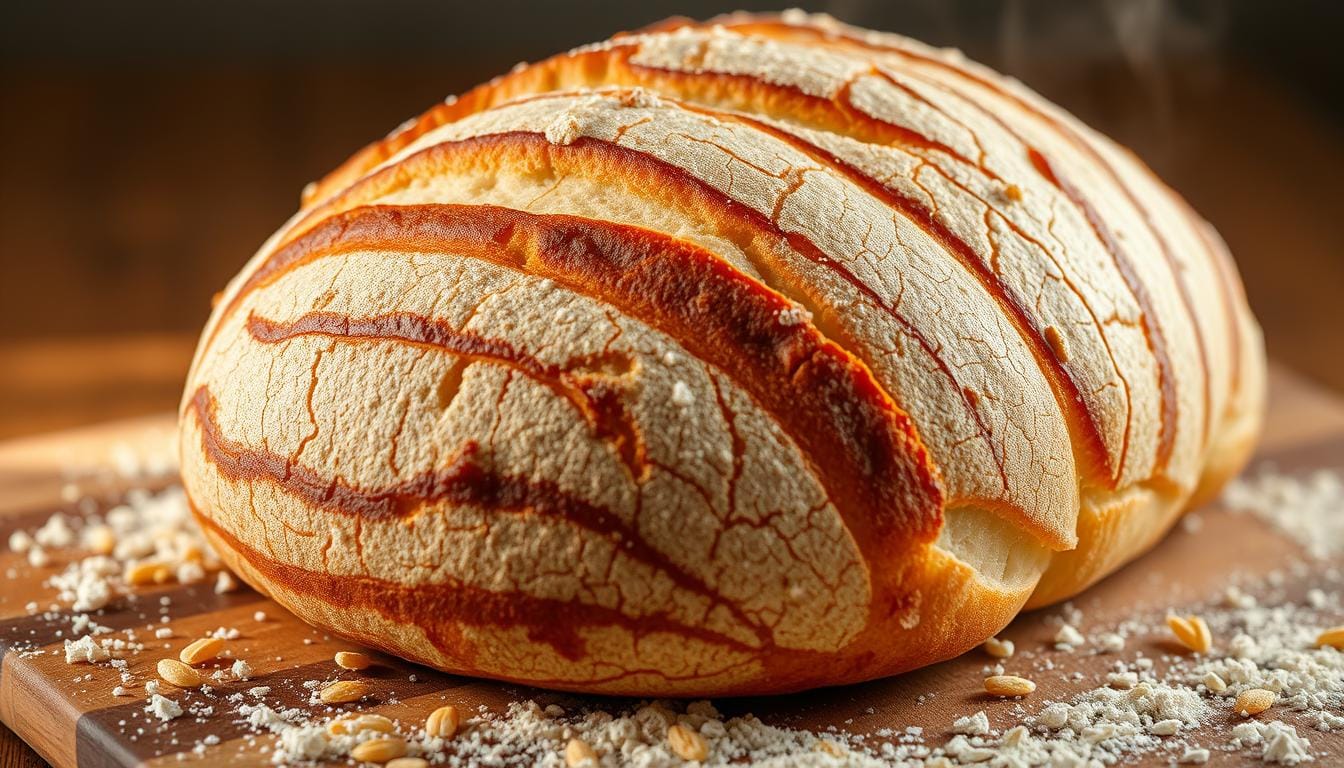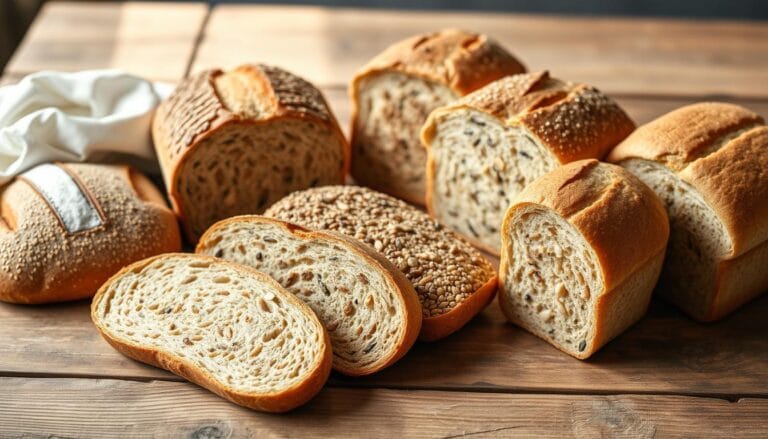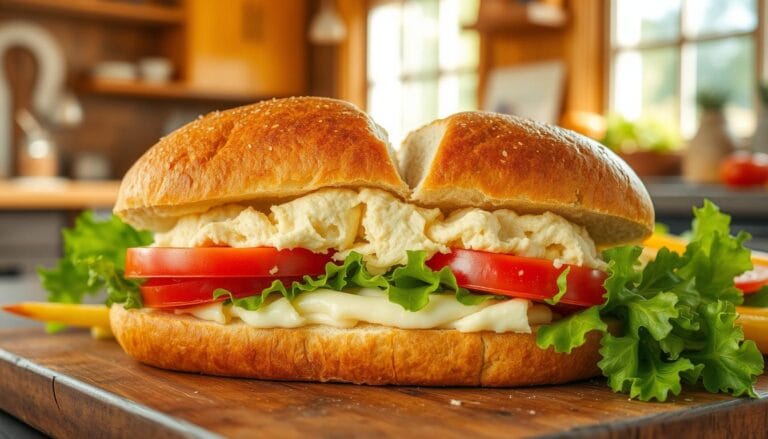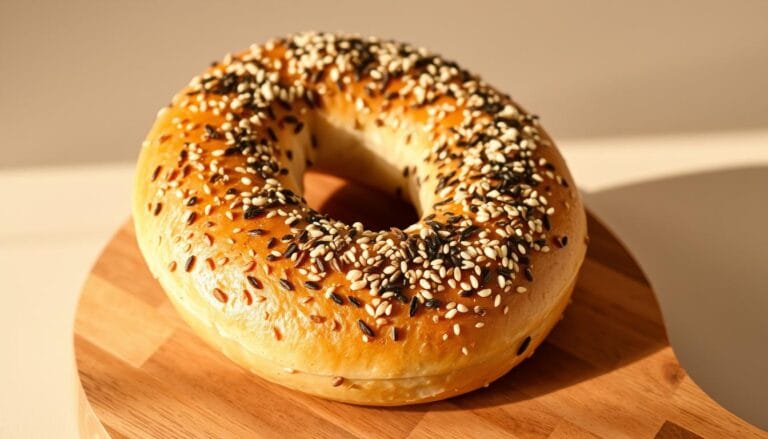Tiger bread: 9 Delicious Pairings You’ll Want to Try
Tiger bread is a beloved artisan bread known for its unique texture and flavor. Its mottled crust hides a soft, pillowy interior. This makes it a hit among those who love baked goods.
Whether you enjoy it in a sandwich or on its own, each bite is a delight. It offers a fascinating contrast that enhances your meal. This bread, also known as Dutch crunch bread, comes from the Netherlands.
It has gained popularity in bakeries across the United States, especially in the San Francisco Bay area. Learning about tiger bread’s baking process adds to your appreciation. It shows how simple ingredients can create such a remarkable treat.
Table of Contents
What is Tiger Bread?
Tiger bread, also called Tijgerbrood in the Netherlands, is a special loaf. It’s known for its unique look and feel. This bread is loved in many places, known as Dutch crunch or Marco Polo bread.
The rice flour paste applied before baking makes it look like a tiger’s fur. This gives it a striped, crunchy crust.
So, what is tiger bread? It’s a sweet, crunchy outside with a soft inside. It’s perfect for sandwiches or on its own. You can find it in local delis and sandwich shops, especially in the San Francisco Bay Area.
To make tiger bread, you need the right ingredients and steps. You’ll need 550 grams of bread flour and 7 grams of instant yeast. These help make the bread strong.
The rice flour glaze uses 70 grams, or you can use ground white rice instead. With about 250 ml of lukewarm water, the dough gets the right moisture. This helps develop the flavors and texture.
Cooking at 200 °C makes the outside golden and keeps the inside soft. Making tiger bread takes about 4 hours and 10 minutes. This includes rising times, making it perfect for weekends or special days.
Origins of Tiger Bread
Tiger bread, also known as tijgerbrood in Dutch, has a rich history in the Netherlands. It first appeared in the 1970s, marking its debut in the culinary world. Despite its Dutch roots, it has gained a big following in the U.S., where it’s called Dutch crunch bread.
Oregon has a special connection to Dutch bread, with its first mention in the 1930s. Its popularity soared in the 1970s in San Francisco, thanks to big advertising campaigns.
Although there’s no record of tiger bread in the Netherlands before 1973, a bakery from 1903 likely helped create it. The name “tiger bread” comes from the Dutch “tijgerbrood,” which means “tiger bread.” It looks like a tiger because of its striped crust.
As it became more popular, big grocery stores in the U.K. started selling tiger bread. Sainsbury’s even called it “giraffe bread” after a kid’s letter. In the U.S., places like Ike’s Love and Sandwiches have helped spread Dutch Crunch, making it available in Texas and other states. Small shops in big cities still sell Dutch Crunch, keeping its San Francisco roots alive.
| Year | Event | Location |
|---|---|---|
| 1903 | Bakery established that might have produced tijgerbrood | Netherlands |
| 1930s | First reference to Dutch Crunch in the U.S. | Oregon |
| 1970s | Popularity of Dutch Crunch surges | San Francisco |
| 1973 | First documented use of the name tiger bread | Netherlands |
How Tiger Bread Gets Its Unique Texture
The baking process of tiger bread is what makes it special. A rice flour paste mixed with water, sugar, and yeast is key. This paste is spread on the dough before baking, giving it a unique texture.
When the bread bakes, the paste dries and cracks. This creates a mottled crust that’s crunchy. It adds a nice contrast to the soft inside of the bread.
Tiger bread is great for sandwiches or with soups. Its popularity, especially in the San Francisco Bay area, shows it’s a favorite. Its unique texture and flavors make it a hit.
Ingredients Used in Tiger Bread
Making perfect tiger bread starts with the right ingredients. You’ll need high-gluten bread flour, water, yeast, sugar, and salt. Each is key to the bread’s flavor and texture.
The rice flour topping is what makes tiger bread’s crust special. It’s mixed with water, sugar, and a bit of salt to create a paste. This paste cracks during baking, making the bread’s pattern.
Yeast is crucial for the dough’s rise. It’s used in both the bread and the rice glaze. This makes the bread light and airy. The dough needs a warm place to rise best.
| Ingredient | Amount | Function |
|---|---|---|
| Bread Flour | 550 g | Main structure |
| Water | 250 ml | Hydration |
| Instant Yeast | 12 g | Fermentation |
| Rice Flour | 70 g | Topping crust |
| Sugar | 15 g | Flavor and crust |
| Salt | 10 g | Flavor and balance |
Tiger Bread vs. Dutch Crunch Bread
The terms tiger bread vs Dutch crunch often refer to the same delightful bread. Regional preferences may dictate its name. In the United States, especially in San Francisco and the Bay Area, it’s known as Dutch crunch bread. This variation has the same characteristics, making it a favorite among many.
Both styles have a crunchy exterior and a soft, airy interior. This mix of textures makes them appealing for many dishes. The rice flour coating adds a sweet flavor, enhancing the bread comparison.
The original name tiger bread comes from the early 1900s in the Netherlands. Its first mention in the United States was in a 1935 Eugene, Oregon newspaper. Since then, Dutch crunch bread has become very popular, especially in the Bay Area.
Whether you call it tiger bread or Dutch crunch, both are delicious additions to meals. They’re versatile, working well with sweet toppings like chocolate sprinkles or savory ingredients for gourmet sandwiches. Despite the name differences, their appeal is undeniable and enjoyed by all.
Popular Recipes for Tiger Bread
Exploring tiger bread recipes is a fun journey. You’ll love the unique flavor and texture of this bread. The classic recipe uses simple, quality ingredients for a delicious loaf. Learning the right baking techniques ensures your tiger bread turns out perfectly every time.
Classic Tiger Bread Recipe
The classic tiger bread recipe combines nutritious ingredients for its famous texture. Here’s what you need:
| Ingredient | Amount |
|---|---|
| Bread flour | 2 ½ cups (300g) |
| Active dry yeast | 1 ⅛ teaspoons |
| Granulated sugar | 1 tablespoon + 1 teaspoon |
| Kosher salt | 1 teaspoon |
| Milk | ½ cup + 3 tablespoons (156g) |
| Unsalted butter (melted) | 4 tablespoons (57g) |
| Rice flour (for topping) | ¼ cup (30g) |
| Water (for topping) | 2 to 3 tablespoons |
Baking Techniques for Best Results
When making tiger bread, focus on a few key baking techniques. To get the perfect crust, apply the rice flour topping before baking. It’s important to manage the temperature during rising and baking. Make sure the water is about 130°F when mixing with instant yeast for best results.
- Mix dough for about 10 to 15 minutes until it pulls away from the bowl.
- Let the dough rise for 1 ½ hours for proper expansion.
- Bake for 30 to 40 minutes based on the size of your loaf or rolls.
- Check doneness with a digital thermometer; the bread should read at least 210°F.
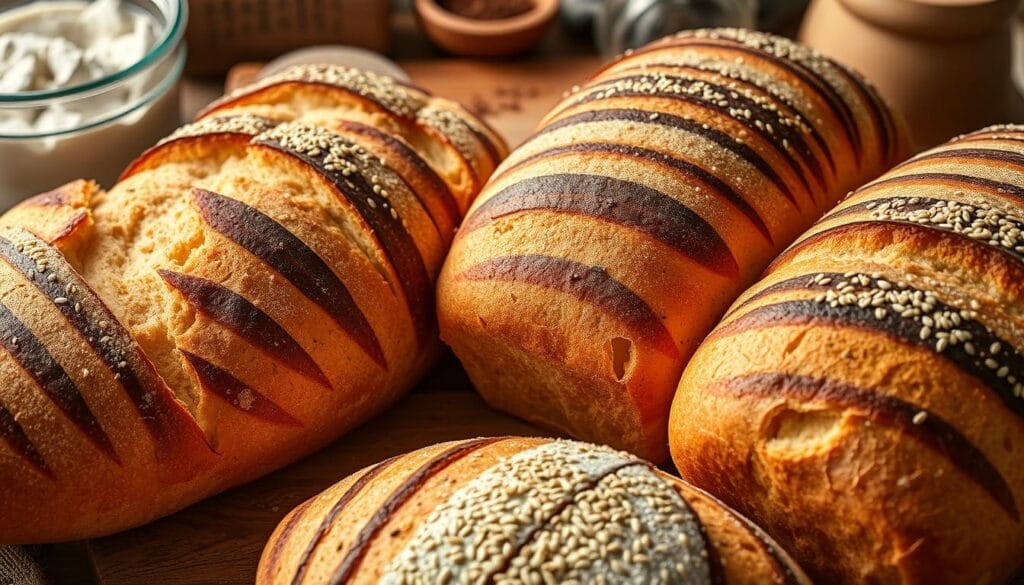
Mastering these techniques and the classic recipe will delight you. Tiger bread’s crunchy crust and soft interior make it a great addition to any meal. You’ll impress your family and friends with your baking skills.
Why You Should Try Tiger Bread
Tiger bread is more than just a loaf. It offers a taste experience that sets it apart. Its crunchy outside and soft inside make every bite a culinary adventure. The sweet crust pairs well with savory fillings, making it perfect for sandwiches.
It’s also great for dipping. Try it with a warm bowl of soup for a delightful crunch. If you haven’t tried tiger bread yet, now’s the time. Its versatility will delight both casual eaters and food lovers.
| Aspect | Description |
|---|---|
| Taste | A delightful combo of crunch and softness |
| Perfect for | Sandwiches and soup dipping |
| Culinary Adventure | Exploring flavors and fillings |
| Experience | A unique texture unique to tiger bread |
| Versatility | Great with various toppings and fillings |
Serving Suggestions for Tiger Bread
There are many serving suggestions to make tiger bread even better. It’s great for sandwiches because its crisp crust and soft inside don’t overpower fillings. Try putting turkey, cheese, and veggies between slices for a tasty meal.
Another good way to enjoy tiger bread is with your favorite soups or stews. Its crunchy crust soaks up liquids, adding flavor and texture. It’s perfect with tomato soup or chicken stew.
Adding tiger bread to a charcuterie board is also a hit. Mix it with cheeses like aged cheddar or Brie, and cured meats like prosciutto or salami. This combo will wow your guests and make any event special.
To find out how to enjoy tiger bread, try it in sandwiches, soups, or on charcuterie boards. The options are endless, and every time, it’s a hit.
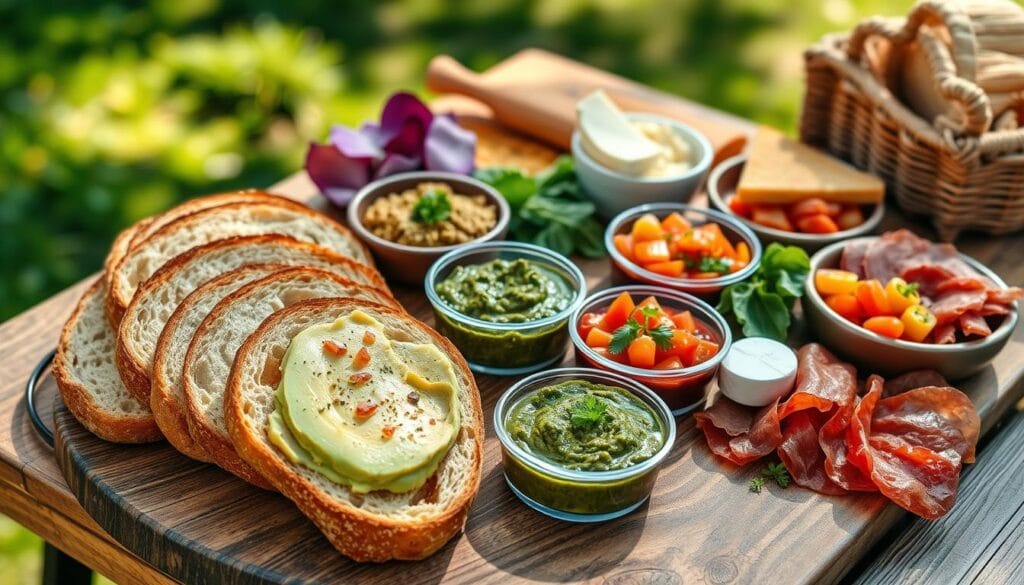
Conclusion
Tiger bread is a tasty bread that makes meals better. It has a special texture that makes eating more enjoyable. This bread, with its interesting history and unique making process, is more than just bread.
It’s great as a side or for making tasty sandwiches. Tiger bread is a flexible choice for many dishes. It’s perfect for any meal.
Exploring tiger bread will deepen your love for its rich culture and taste. The rice flour topping and soft inside show the effort put into making it. If you haven’t tried it yet, now’s the time to add it to your cooking.
Adding tiger bread to your meals can make them stand out. It’s a great way to impress anyone. Let tiger bread bring excitement and joy to your food.

